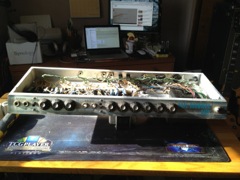Refresher on Tube Amp Electronics and Troubleshooting (2015)
Fender Dual Showman silver face Model AB763 (1968) [ Link ]
This is a 'blog' of my efforts to repair and rejuvinate the guitar amp that I bought new in 1968 and has sat idle in my basement family room for 30 years.
Almost the first site I found on Google was a YouTube video from Uncle Doug: How Tube Amplifiers Work, Part 1: The Power Supply. Of course this lead to Part 2 and then a series of additional videos from Uncle Doug on the subject of tube amplifier repair. These are particulalary useful because he uses Fender Amps as examples and most of these vintage Fender models have the same basic design.
- Cathode Bypass Capacitors: How they Affect Gain and Tone. Describes Common Cathode Circuit with grid bias.
- Cathode Bypass Capicitor Calculator. (web site link to calculator)
- Biasing Single-Ended Amplifiers (watch first ) (YouTube Link)
- Biasing Double-Ended Amplifiers Part I (YouTube Link)
- Biasing Double-Ended Amplifiers Part II (YouTube Link)
Here are some videos that have been helpful from Uncle Doug:
- Here is a video from another source on repair of Fender Deluxe (video link) This describes the setting of biasing and replacing filter caps that were misstakenly installed. Not as good as Uncle Doug but...
- Here is a LONG video on repair of Fender tube amp repair (Gerald Weber) [link] Gerald talks about tubes, ground bus, cap replacement, filiment wireing error, discharge caps (clip test lead to pin 1 of any pre-amp tube and switch all on). This is a great general discussion of techniques and principals in repairing a fender amp. Like I said this is long but it's a good show and worth the time to watch at least once. At about 50 min he talks about checking bias voltages and tube voltages. @1:05 adjusting bias current on power tubes and balance.
- Gerald Weber - Fender Silverface Amp to Blackface Amp AB763 - Recap & Resistor Replacments The re-cap part of this video helped me helped me with identify the filter caps in the can on the top of the chassis. He talkes about changes in value for these caps and why (why not). The other mods he was talking (siverface to blackface) didn't apply to my amp. My amp has "black face" characteristics already.
- Repairing a Fender Twin Reverb Michael Earnart (YouTube) Weak channel is caused by a blown resistor. He tracks this down by measuing voltages on pins 1 and 6 of the pre-amp and oscilator tubes. He finds one very low and tracks it back to the resistor that's open. I include this as an example of a troubleshooting technique (that hasn't worked in my case -- yet).
Here are some videos from other sources:
